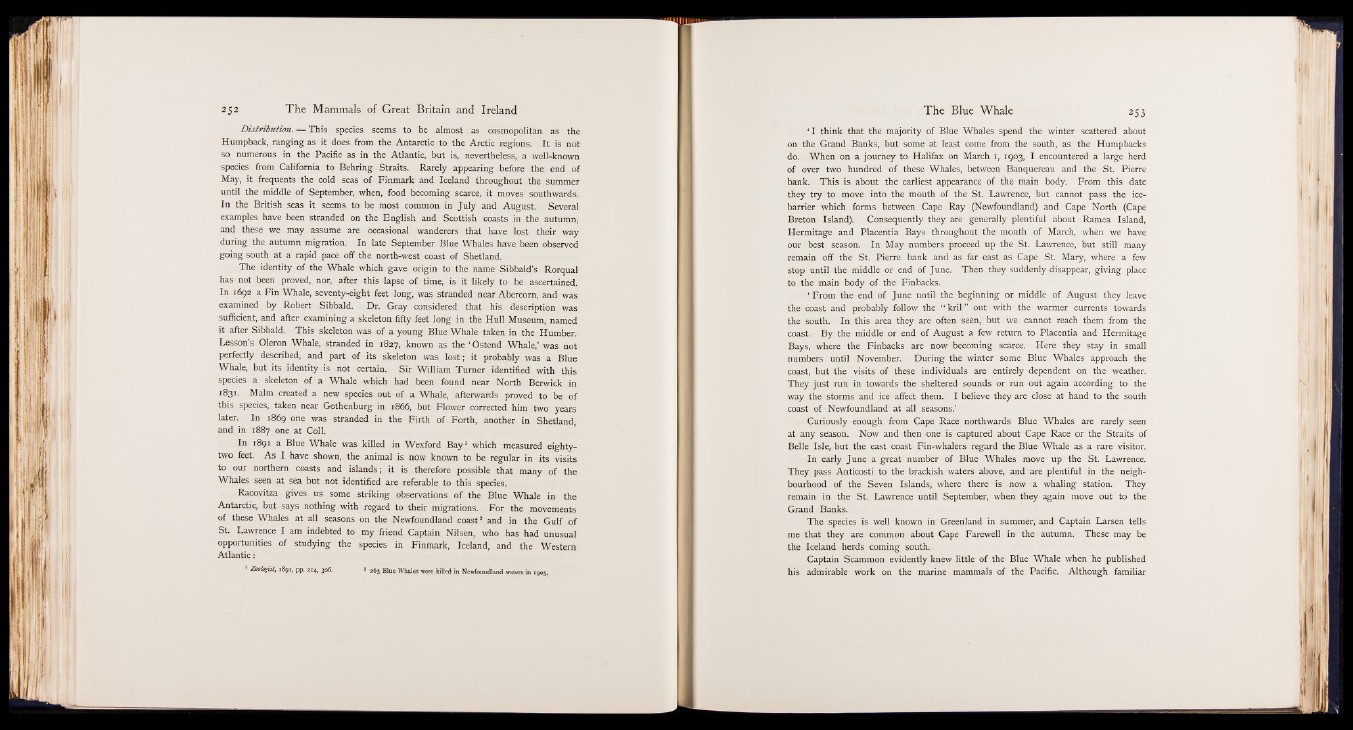
Distribution. — This species seems to be almost as cosmopolitan as the
Humpback, ranging as it does from the Antarctic to the Arctic regions. It is not
so numerous in the Pacific as in the Atlantic, but is, nevertheless, a well-known
species from California to Behring Straits. Rarely appearing before the end of
May, it frequents the cold seas of Finmark and Iceland throughout the summer
until the middle of September, when, food becoming scarce, it moves southwards.
In the British seas it seems to be most common in July and August. Several
examples have been stranded on the English and Scottish coasts in the autumn,
and these we may assume are occasional wanderers that have lost their way
during the autumn migration. In late September Blue Whales have been observed
going south at a rapid pace off the north-west coast of Shetland.
The identity of the Whale which gave origin to the name Sibbald’s Rorqual
has not been proved, nor, after this lapse of time, is it likely to be ascertained.
In 1692 a Fin Whale, seventy-eight feet long, was stranded near Abercorn, and was
examined by Robert Sibbald. Dr. Gray considered that his description was
sufficient, and after examining a skeleton fifty feet long in the Hull Museum, named
it after Sibbald. This skeleton was of a young Blue Whale taken in the Humber.
Lesson’s Oleron Whale, stranded in 1827, known as the 4 Ostend Whale,’ was not
perfectly described, and part of its skeleton was lo st; it probably was a Blue
Whale, but its identity is not certain. Sir William Turner identified with this
species a skeleton of a Whale which had been found near North Berwick in
1831. Malm created a new species out of a Whale, afterwards proved to be of
this species, taken near Gothenburg in 1866, but Flower corrected him two years
later. In 1869 one was stranded in the Firth of Forth, another in Shetland,
and in 1887 one at Coll.
In 1891 a Blue Whale was killed in Wexford Bay1 which measured eighty-
two feet. As I have shown, the animal is now known to be regular in its visits
to our northern coasts and islands; it is therefore possible that many of the
Whales seen at sea but not identified are referable to this species.
Racovitza gives us some striking observations of the Blue Whale in the
Antarctic, but says nothing with regard to their migrations. For the movements
of these Whales at all seasons on the Newfoundland coast2 and in the Gulf of
St. Lawrence I am indebted to my friend Captain Nilsen, who has had unusual
opportunities of studying the species in Finmark, Iceland, and the Western
Atlantic:
' I^9 Ii PP- 214» * 263 Blue Whales were killed in Newfoundland waters in 1905.
‘ I think that the majority of Blue Whales spend the winter scattered about
on the Grand Banks, but some at least come from the south, as the Humpbacks
do.. When on a journey to Halifax on March i, 1903, I encountered a large herd
of over two hundred of these Whales, between Banquereau and the St. Pierre
bank. This is about the earliest appearance of the main body. From this date
they try to move into the mouth of the St. Lawrence, but cannot pass the ice-
barrier which forms between Cape Ray (Newfoundland) and Cape North (Cape
Breton Island). Consequently they are generally plentiful about Ramea Island,
Hermitage and Placentia Bays throughout the month of March, when we have
our best season. In May numbers proceed up the St. Lawrence, but still many
remain off the St. Pierre bank and as far east as Cape St. Mary, where a few
stop until the middle or end of June. Then they suddenly disappear, giving place
to the main body of the Finbacks.
4 From the end of June until the beginning or middle of August they leave
the coast and probably follow the “ kril” out with the warmer currents towards
the south. In this area they are often seen, but we cannot reach them from the
coast. By the middle or end of August a few return to Placentia and Hermitage
Bays, where the Finbacks are now becoming scarce. Here they stay in small
numbers until November. During the winter some Blue Whales approach the
coast, but the visits of these individuals are entirely dependent on the weather.
They just run in towards the sheltered sounds or run out again according to the
way the storms and ice affect them. I believe they are close at hand to the south
coast of Newfoundland at all seasons.’
Curiously enough from Cape Race northwards Blue Whales are rarely seen
at any season. Now and then one is captured about Cape Race or the Straits of
Belle Isle, but the east coast Fin-whalers regard the Blue Whale as a rare visitor.
In early June a great number of Blue Whales move up the St. Lawrence.
They pass Anticosti to the brackish waters above, and are plentiful in the neighbourhood
of the Seven Islands, where there is now a whaling station. They
remain in the St. Lawrence until September, when they again move out to the
Grand Banks.
The species is well known in Greenland in summer, and Captain Larsen tells
me that they are common about Cape Farewell in the autumn. These may be
the Iceland herds coming south.
Captain Scammon evidently knew little of the Blue Whale when he published
his admirable work on the marine mammals of the Pacific. Although familiar